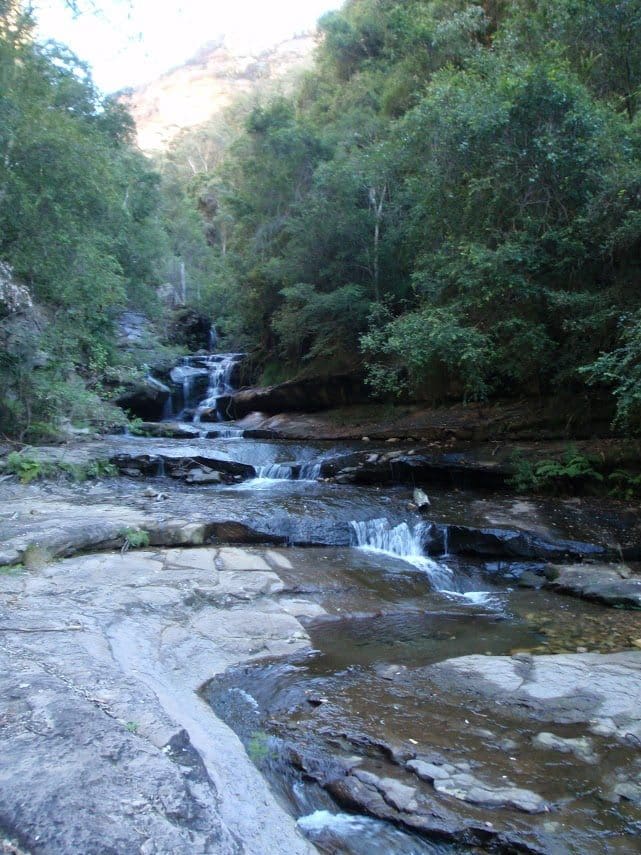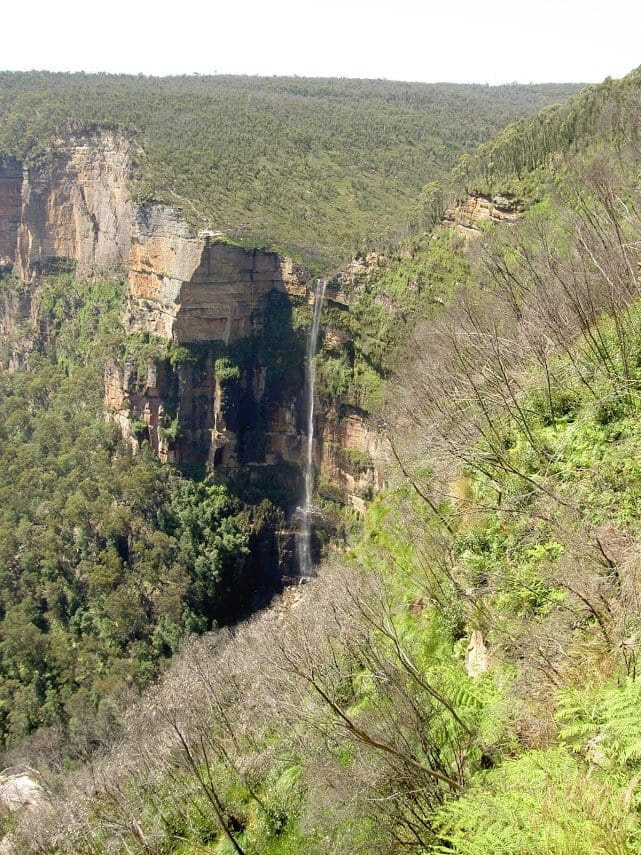Hike at a Glance
Max elevation: 1061m
Min elevation: 880m
Total Ascent: 313m
Hike overview
Collier’s Causeway is a striking 4km trail tucked beneath the towering escarpments of Blue Mountains National Park in New South Wales. Generally taking around 1.5 hours to complete, this Grade 4 walk offers a rich mix of scenery—towering sandstone cliffs, shady gullies, open heath, and sweeping views across the Kanimbla Valley. It’s a one-way route best tackled from Bundarra Street to Burton Avenue, with convenient access to a number of popular climbing areas along the way. While relatively short, the track’s rugged terrain and steep sections demand a reasonable level of fitness and sure-footedness.
Starting at the corner of Bundarra Street and Eveleigh Avenue, the track drops gradually, skirting the boundary between suburban backyards and bushland. The sounds of the town fade quickly, replaced by birdsong and the rustle of leaves. A short way in, the path passes a telegraph pole and continues down towards the valley. Boardwalks help protect the fragile heath as the trail winds through low scrub, eventually bringing you to the cool, sheltered banks of Centennial Glen Creek. This is a lovely place to pause—rock seats are tucked beneath a cliff, and the air is often cooler here, even on warm days.
From the creek, the track veers right and begins to sidle around the hillside, beneath dramatic cliffs that seem to lean in overhead. Not far beyond, the trail breaks into open heath again before reaching a rocky slab with arrows directing walkers to either Porters Pass or Fortress Rock. A brief detour here leads to Fort Rock, a free-standing sandstone pillar that rises abruptly from the hillside like a giant chess piece. From the top, there are unimpeded views stretching out over both the Megalong and Kanimbla Valleys. It's a peaceful spot—quiet and detached—perfect for a break if you’re feeling unhurried.
Returning to the main route, the trail turns left at the signed arrow to Porters Pass and heads downhill into thicker vegetation. Stone stairs descend through a tight crevice before opening out again at the base of sheer cliffs. A waterfall spills across the track, depending on recent rain, and moss-covered rock adds a damp, cool feel to this section. The trail continues to hug the cliffs until it reaches a painted boulder marking Porters Pass. From here, a series of narrow steps zigzag downward, weaving between rock walls and shaded gullies.
Just below, an optional detour branches off sharply to the right. This lesser-used path follows a rock ledge alongside the creek, leading to a quiet pool and waterfall. The footing here is more uneven and can be slippery in wet conditions, but it's a worthwhile side trip for those drawn to quieter corners and canyon-like landscapes. After visiting, you’ll need to retrace your steps to rejoin the main trail.
Continuing along the primary route, the track dips further into the gorge, with stairs cut directly into the cliff face and railings in place for support. After crossing over large rocks and reaching the opposite side of the pass, the path begins to follow the base of the cliffs once again. About a kilometre later, the track climbs through a narrow pass and begins its steady ascent out of the gorge. It crosses a rocky slope—complete with handrails in steeper spots—and passes between two tall trees before reaching a small creek.
The final climb begins here. A steep series of rock steps pulls the trail out of the gorge, and as you rise, the landscape opens up once more. The Kanimbla Valley reappears through gaps in the trees, offering another opportunity to pause and take in the view. Several faint paths snake uphill from here, all converging at a large rocky outcrop. From this point, a short flight of stairs continues up to an unsigned intersection.
Keeping straight ahead, the track dips slightly, levels out, then climbs once more before finishing at the end of Burton Avenue. The road signals a return to civilisation, but the memory of shaded gullies, cliffside ledges, and valley views lingers long after you’ve kicked off your boots. Collier’s Causeway is a rewarding walk for those wanting a taste of the Blue Mountains’ wilder edges—short enough to complete in a morning, yet immersive enough to feel far from the everyday.
Content use
Please don’t copy GPX files or content from this site to AllTrails or other platforms. Each trail has been personally mapped, documented, and refined to support Australia’s bushwalking and hiking community. While some details come from land managers, every listing reflects significant personal effort. This is a free, community-driven initiative—your respect helps keep it that way.
Walk map and GPX file
Max elevation: 1061 m
Min elevation: 880 m
Total climbing: 313 m
Total descent: -289 m
Getting there
Getting to the trailhead: Blue Mountains National Park.
The walk begins either at the end of Bundarra Street in Blackheath, offering convenient access to the trailhead.
Closest towns to this walk: Blackheath, Bullaburra, Hazelbrook, Katoomba, Lawson, Leura, Lithgow, Mount Victoria, Springwood, Wentworth Falls, Woodford
About the region
Blackheath, perched on the edge of the Grose Valley in Blue Mountains National Park, offers a stunning mix of lookouts, walking trails, and quiet bushland escapes. It’s a favourite for walkers, families, and outdoor enthusiasts alike, with sweeping valley views, towering cliffs, and a strong sense of wilderness just minutes from town. Govetts Leap and Evans Lookout are two of the most popular vantage points, each offering expansive views across the sandstone cliffs and deep gorges of the Grose. From Govetts Leap, Bridal Veil Falls drops 180 metres in a single, elegant plunge—an impressive sight in full flow.
For those keen to stretch their legs, the Cliff Top walking track links the two lookouts, winding through eucalypt forest and heath with near-constant views. A little further afield, Pulpit Rock offers one of the area’s most dramatic viewpoints, perched high above the valley. Walkers looking for more of a challenge can follow the steep descent from Govetts Leap into the valley below, passing waterfalls and hanging swamps on the way to the Blue Gum Forest, where ancient eucalypts tower overhead in a place deeply rooted in conservation history.
The area is well equipped for longer visits too. Perrys Lookdown campground is a great base for exploring deeper into the Grose Wilderness, especially for those heading to the remote Acacia Flat campground. For a gentler option, the Fairfax Heritage Track near the Blue Mountains Heritage Centre offers an accessible walk with vibrant wildflowers in spring. Mountain bikers can hit the Burramoko Ridge Trail, and the Grand Canyon Walk offers a lush, fern-filled experience through a deep sandstone gorge—no technical gear required.
Whether you’re here for a picnic with a view, a full-day hike, or an overnight wilderness adventure, Blackheath delivers a memorable experience shaped by rugged beauty and a real sense of scale.
Similar walks nearby
Looking for more walks in or near Blue Mountains National Park? Try these trails with a similar difficulty grade.
Track grade
Grade 4 (Hard) - Challenging Walks for Experienced Walkers: Grade 4 on the AWTGS signifies challenging walking tracks. Bushwalking experience is recommended for these tracks, which may be long, rough, and very steep. Directional signage may be limited, requiring a good sense of navigation. These walks are suited for experienced walkers who are comfortable with steeper inclines, rougher terrain, and potentially longer distances.
Explore safe
Plan ahead and hike safely! Carry enough water, pack layers for changing conditions, and bring safety gear like a torch, PLB, and reliable communication device. Check official sources for trail updates, closures, and access requirements, and review local weather and bushfire advice. Most importantly, share your plans with someone before you go. Being prepared makes for a safer and more enjoyable hike! Stay Safe, Explore More, and Always #ExploreSafe.
Packing checklists
What you carry in your pack depends on factors like weather, terrain, and your adventure type. Not sure what to bring? My free planning, food, and packing checklists are a great starting point, covering day hikes, overnight trips, and multi-day adventures. Use them to customise your kit and always prioritise safety.
Let someone know
Before heading out, take a moment to fill out your trip intentions form. It’s a quick way to share your hike details with family or friends. If something goes wrong, they can notify emergency services, ensuring a faster response and peace of mind. Stay safe and enjoy your adventure
Suggest an edit
Spotted a change on this trail? Maybe there are new features, the route has shifted, or the trail is permanently closed. Whatever the update, I’d love your input. Your feedback helps fellow hikers stay informed and ensures that our trail info stays fresh and reliable.
Acknowledgement of Country
Trail Hiking Australia acknowledges the Traditional Owners of the lands on which we hike and pay respects to their Elders, past and present, and we acknowledge the First Nations people of other communities who may be here today.
/Collier's%20Causeway%20Walk%20(3).jpg)
/Collier's%20Causeway%20Walk%20(33).jpg)
/Collier's%20Causeway%20Walk%20(32).jpg)
/Collier's%20Causeway%20Walk%20(11).jpg)
/Collier's%20Causeway%20Walk%20(34).jpg)
/Collier's%20Causeway%20Walk%20(12).jpg)
/Collier's%20Causeway%20Walk%20(21).jpg)
/Collier's%20Causeway%20Walk%20(31).jpg)
/Collier's%20Causeway%20Walk%20(22).jpg)
/Collier's%20Causeway%20Walk%20(7).jpg)
/Collier's%20Causeway%20Walk%20(28).jpg)
/Collier's%20Causeway%20Walk%20(1).jpg)
/Collier's%20Causeway%20Walk%20(30).jpg)
/Collier's%20Causeway%20Walk%20(29).jpg)
/Collier's%20Causeway%20Walk%20(2).jpg)






